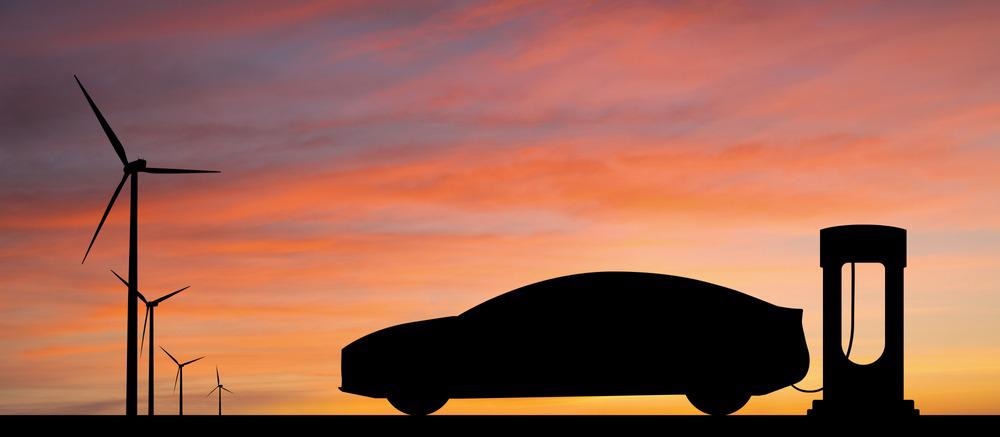A quantum battery that counter-intuitively charges more rapidly the larger it gets could give electric vehicles the edge over fossil fuel alternatives.

Image Credit: Scharfsinn/Shutterstock.com
Batteries have come a long way over the past few decades, becoming more lightweight and capable of carrying vastly more charge. This improvement in batteries has made electric vehicles much more viable as a more ecologically sound alternative to gasoline-powered cars.
As an example of this growth, Tesla will soon release a second-generation Roadster. The original two-seat sports car version, released in 2008, was capable of 245 miles on a single charge of its lithium-ion battery. The new Roadster, according to Tesla, will be able to travel 620 miles on a single full charge.
Yet, as impressive as battery advances are, a power storage device based on the laws of classical physics can only go so far and electronics can only undergo so much miniaturization. This restriction is coupled with the fact that electric vehicles currently take an inconveniently long time to charge, especially from home outlets.
That is what has prompted some researchers to begin investigating if a battery could be designed that is founded on quantum mechanical phenomena such as entanglement, superposition, and coherence, rather than on the laws of classical physics.
What is a Quantum Battery and How Would It Work?
The main advantage of quantum batteries over traditional batteries is the former has a counter-intuitive property in which the recharge time is inversely related to the battery capacity — the amount of stored electrical charge.
One of the ways of achieving this is by exploiting superposition, the principle that says that because a quantum system is described as a wave, it can exist in multiple states — overlapping waves — at a single time, even if these states are contradictory.
The most infamous example of this is Schrodinger’s cat thought experiment. This sees an unfortunate hypothetical cat placed in a sealed box with a diabolical device that releases a deadly poison if an atom decays.
While the box is sealed, it exists in a superposition; when the box is opened, the wavefunction collapses, and a single state manifests.
In a superposition, a whole system behaves collectively, a state known as coherence. This allows molecules to act in unison instigating a hyper-fast charge. The bigger the quantum battery, the more molecules act in unison.
This results in charging speeds that are inverse to battery size, meaning that the bigger a battery gets, and consequently the more charge it can hold, the faster it can charge.
This is superabsorption — larger systems absorb energy faster — and it’s the key idea that makes quantum batteries so enticing, especially for manufacturers of devices that require a lot of power. This includes devices like electric vehicles, which currently take a long time to charge up fully.
How Close Are We to A Quantum Battery?
Recent years have seen some impressive strides in the development of a quantum battery. In January 2022, researchers from the Institute of Photonics and Nanotechnologies of the Cnr and the Politecnico di Milano built a battery that they say uses quantum principles to possess a recharge time inverse to battery capacity.
The team’s research, published in the journal Science Advances, describes the production of a microcavity hosting an active material that consists of organic molecules dispersed in an inert matrix.
Each of these molecules can potentially exist in a superposition of states with two energy states, the ground state — the lowest possible state — and an excited state. This means that the molecules of the system act together, in a state of coherence as described above, leading to hyper-rapid charging. And because of superabsorption, the bigger the battery the quicker the charge.
In addition to this, in October 2019 scientists from the universities of Alberta and Toronto developed a blueprint for a quantum battery that doesn’t leak charge.
The team, who published their work in the Journal of Physical Chemistry C, created an open quantum network model with high structural symmetry as a platform for storing energy created when an electron absorbs a photon of light and hops up to an excited state.
The researchers prevented energy loss by placing this system by placing it in a so-called “dark state”, during which it was incapable of exchanging energy with its environment. This makes the system immune to environmental influence, in turn meaning it is robustly protected against energy loss.
In addition to the return of the Roadster, Tesla is also planning for the launch of electric-powered semi cargo transport with the Tesla Semi. These heavy vehicles and their counterparts will need increasingly versatile batteries, as electric transport begins to dominate the highways.
If achieved, a quantum battery could potentially make the idea of powering vehicles with fossil fuels obsolete, bringing with them a massive boost to carbon targets and the ongoing battle against climate change.
More from AZoQuantum: The Role of Diamonds in Quantum Computing
References and Further Reading
Roadster, Tesla, [https://www.tesla.com/roadster]
Quach. J.Q., McGhee. K. F., Ganzer. L., et al, [2022], “Superabsorption in an organic microcavity: Toward a quantum battery,” Science Advance, https://www.science.org/doi/10.1126/sciadv.abk3160
Liu. J., Segal. D., Hanna. G., [2019], “Loss-Free Excitonic Quantum Battery,” Journal of Physical Chemistry C, https://pubs.acs.org/doi/10.1021/acs.jpcc.9b06373
Disclaimer: The views expressed here are those of the author expressed in their private capacity and do not necessarily represent the views of AZoM.com Limited T/A AZoNetwork the owner and operator of this website. This disclaimer forms part of the Terms and conditions of use of this website.